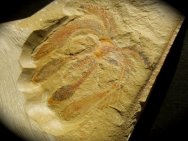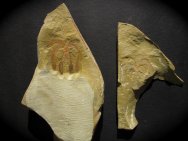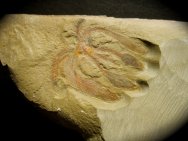Furca
(Marellamorph)
Phylum
Arthropoda, Class Marrellomorpha, Order Marrellida, Family Marrellidae
(Walcott, 1912)
Geological
Time: Ordovician
Size: Fossil
is 33 x 33 (1 ¼”) mm length by width. The larger plate
is 14 x 8 cm (5 ½ x 3 1/8”)
Fossil Site:
Fezouta Formation, Oued Draa, Zagara, Morocco
Fossil Code:
PFT476
Price: $2500.00
- sold
 Description:
The Marrellomorphs are a stem group soft-bodied arthropods known
from the Cambrian to the early Devonian. Because they lacked
mineralized hard body parts, they exclusively occur in the fossil
record in sites of exceptional preservation, often called Burgess
Shale type sites. In fact, the first described Marrellomorph
is Marrella splendens first collected by Charles Doolittle Walcott
in the Burgess Shale of Canada. Marella is the most abundant
and the most common arthropod found in the Burgess shale with
over 15,000 specimens found. Walcott first described Marrella
as a lace crab, and later formally described it as a trilobite.
It was subsequently reassigned to class Trilobitoidea in the
Treatise on Invertebrate Paleontology. Whittington described
it as a stem arthropod in 1971, rejecting it as a trilobite,
chelicerate, or crustacean. Other Marrellomorphs are known from
various Lagerstätten, the oldest being the Kaili biota in
the Guizhou province of southwest China. They are also known
from the Silurian Herefordshire Lagerstätte in England,
the famous Devonian age Bundenbach Hunsrück Slate of Germany
and Ordovician area of Bohemia. Description:
The Marrellomorphs are a stem group soft-bodied arthropods known
from the Cambrian to the early Devonian. Because they lacked
mineralized hard body parts, they exclusively occur in the fossil
record in sites of exceptional preservation, often called Burgess
Shale type sites. In fact, the first described Marrellomorph
is Marrella splendens first collected by Charles Doolittle Walcott
in the Burgess Shale of Canada. Marella is the most abundant
and the most common arthropod found in the Burgess shale with
over 15,000 specimens found. Walcott first described Marrella
as a lace crab, and later formally described it as a trilobite.
It was subsequently reassigned to class Trilobitoidea in the
Treatise on Invertebrate Paleontology. Whittington described
it as a stem arthropod in 1971, rejecting it as a trilobite,
chelicerate, or crustacean. Other Marrellomorphs are known from
various Lagerstätten, the oldest being the Kaili biota in
the Guizhou province of southwest China. They are also known
from the Silurian Herefordshire Lagerstätte in England,
the famous Devonian age Bundenbach Hunsrück Slate of Germany
and Ordovician area of Bohemia.
The
Furca Marellamorph shown here was recently discovered in the
Ordovician strata of the
Fezouata Formation north of Zagora
in southeastern Morocco. Van Roy et. al. (Ordovician faunas
of Burgess Shale type, Nature 465, 2010) recently described the
Biota from this new site containing "stem-group morphologies
normally considered characteristic of the Cambrian". The
site provide strong evidence that the Cambrian explosion fauna
radiation persisted into the Ordovician during a period described
as the "Great Ordovician Biodiversification Event".
Unfortunately, there are few sites so far discovered where the
conditions for preservation of soft-bodied animals existed in
the early Ordovician.
This
Furca Marellamorph was among a handful available at the Tucson
fossils show, and was far and away the
best of them commanding a concomitant high price; most are
far less detailed. The fossil is both part and counterpart and
has all six appendages present, as well as the head and long
tapered
segmented
body.
Note the delicate filaments structures preserved at the ends
of the appendages. Absolutely no restoration or enhancement
has taken place. The yellows and red are naturally occurring
oxides.
Some additional air scribe work was done to reveal the lower
appendages. |
|


